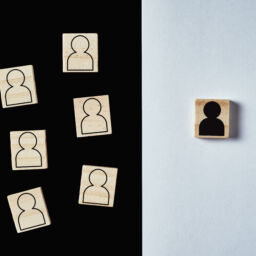
Hate Crimes and Their Effects On Society
by- Amanda Hildreth
A hate crime is abuse, violence, or intimidation of a person for being part of a protected class or certain other groups. Victims might be targeted for their gender or sexuality, such as being transgender, gay, bisexual, non-binary, queer, intersex, for being a different race, ethnicity, religion, or sex than their abuser, or for having a disability.
Hate Crimes and Their Effects
Victims of violent hate crimes are more likely to experience psychological distress than Victims of another violent crime (Herek Gillis & Cogan, 1999). Victims of crimes that are motivated by bias have a greater chance of experiencing PTSD, depression, anxiety, safety concerns, and anger than Victims of non-bias-motivated crimes (Boeckmann & Turpin-Petrosino, 2022; Gerstenfeld, 2011; McDevitt et al., 2001).
Hate crimes send a message to the members of the Victim’s circle that they are unsafe in the community, resulting in decreased feelings of security within the entire group (Bell, & Perry, 2015; Noelle, 2002). Witnessing discrimination against a person’s own group can also also lead to distress and low self-esteem (McCoy & Major, 2003).
What Causes Hate Crimes?
Hate crimes are forms of extreme prejudice and are often ignited by social or political change. Public or political influences may undervalue members of unfamiliar groups (Franklin, 1997), and perpetrators of hate crimes may feel that their way of life is threatened by demographic changes (Stacey et al., 2011).
Perpetrators of hate crimes are often motivated by fear, ignorance, or anger rather than hate. All these behaviors can lead to dehumanization of unfamiliar groups, which produces targeted aggression (2014; Nemiroff, 1995; Plumm et al., 2014).
How Common Are Hate Crimes?
In 2017, the FBI reported 7,145 hate crimes (FBI, 2016). However, most hate crimes are not reported. Of the hate crimes reported in 2017, 58.1% were based on hostility towards race or ethnicity, 22% towards religion, 15.9% towards sexual orientation, 0.6% towards gender identity, and 1.6% towards disability. The majority of these crimes targeted African-American, LGBTQ, and Jewish communities.
COVID’s Impact On Hate Crimes
COVID-19 peaked in China in the last week of 2019. As Americans and the rest of the world got used to the new normal of social distancing and stay at home orders, Asian Americans had been experiencing heightened racial tension, verbal, and physical attacks. Despite the disease impacting people of all ethnicities and races, Asian Americans were reporting high rates of hate crimes against them (Chiu, 2020).
Covid-19 has created national insecurity and enabled the spread of racism and xenophobia, which could be associated with the increase in anti-Asian hate crimes during the pandemic (Vachuska, 2020).
The Different Forms of Abuse Associated with Hate Crimes
Hate crimes aren’t just Verbal Abuse or Physical Assault, although both activities can be a part of a hate crime. Forms of abuse that can also be considered a hate crime are damage to items of cultural or religious importance, crime intentionally occurring on a holy day, and symbols of hatred present before, during, or after the crime (Victim Connect Resource Center, 2022).
A hate crime can also happen through words, pictures, videos, music, and more. Hate content includes:
- Messages that call for violence against a specific person or group.
- Web Pages that show videos or pictures of violence against anyone for their differences.
- Chat Forums that encourage others to commit hate crimes against a specific group or person (Metropolitan Police, 2022).
What Can I Do If I’ve Been A Victim Of A Hate Crime?
While there are no actions that are correct for everyone after a hate crime, the following are steps you can take if you feel comfortable doing so.
- Call 911 if you feel that you are in danger or need medical assistance.
- Make a record of what happened. Write as much detail as possible after the crime, and include any hate speech to suggest biased motivation.
- File a police report and obtain a copy for your records.
- Talk with friends or family you trust. Lean on them if you need help with rides to appointments, dealing with any possible media attention, coordinating meals, or other tasks.
- Reach out to an advocate support group for Victims of hate crimes for information, resources, and services that can help.
- Hire an attorney if there will be a criminal case or if you would like to file a civil lawsuit.
- If you don’t feel that local authorities are taking your case seriously, you can file a report with your local FBI field office (Victim Connect Resource Center, 2022).
How To Stop Hate Crimes In Our Communities
There are many ways you can get involved to stop hate crimes in your communities.
- Identify Partners: Create and foster partnerships within the community to combat crime. Include diverse groups who may be targets of hate. Community partners include law enforcement, schools, courts, Victim advocates, federal agencies, community organizations, the media, religious groups, civic leaders like council members, and more. Community policing enables communities to join with law enforcement to prevent hate crimes.
- Develop Law Enforcement-Community Relationships: A strong partnership between law enforcement and communities is key to preventing hate crimes. Research and understand how involved local law enforcement is with the community, reach out to the chief of police to participate in the relationship, focus on solutions, and network with others in the community.
- Identify a Group To Interface with Law Enforcement for a Victim: Victims of hate can be mistrustful or possibly fearful of law enforcement and may turn to their community groups instead for support. Those organizations can link with law enforcement and get them involved on behalf of the Victim.
- Invite Law Enforcement and Community Groups To Schools: Most hate and bias-motivated crimes are committed by people under 30, and 17% of those crimes are committed by someone under 18. Youth are also more vulnerable to violent attacks and other forms of harassment. To combat hate crimes and bias, teachers and school administrators could use law enforcement to educate students and staff.
- Promote Public Awareness: Provide a community public awareness campaign to create awareness. The campaign can identify intolerance and provide resources for Victims and community members (The US Department of Justice, 2022).
We at ARO are here to support you in your personal healing journey to complete well-being. We bring awareness and education to 13 different types of abuse including Narcissistic, Sexual, Physical, Psychological, Financial, Child, Self, Cyberbullying, Bullying, Spousal, Elderly, Isolation, and Workplace, and help others heal and find peace. Please support our efforts by going to GoARO.org to learn how you can make an impact on the Abuse Care Community.
For more information about hate crimes, visit the United States Department of Justice.
References
American Psychological Association and the Society for the Psychological Study of Social Issues. Washington, D.C.
Bell, J. G., & Perry, B. (2015). Outside looking in: The community impacts of anti-lesbian, gay, and bisexual hate crime. Journal of Homosexuality, 62(1), 98–120.
Boeckmann, R.J., & Turpin-Petrosino, C. (2002). Understanding the harm of hate crime. Journal of Social Issues, 58, 207–225.
Carrier, Jim (1999); The US Department of Justice (2022). Ten ways to fight hate: A community response guide, second edition. https://www.splcenter.org/sites/default/files/com_ten_ways_to_fight_hate_2017_web.pdf
Chiu, A. (2020, March 20). Trump has no qualms about calling the coronavirus the ‘Chinese Virus.’ That’s a dangerous attitude, experts say. The Washington Post. https://www.washingtonpost.com/nation/2020/03/20/coronavirus-trump-chinese-virus/
Federal Bureau of Investigation. (2016). Hate crime statistics, 2015. Washington, D.C.: U. S. Department of Justice.
Franklin, K. (1997). Psychosocial motivations of hate crime perpetrators: Implications from prevention and policy. https://files.eric.ed.gov/fulltext/ED423939.pdf.
Gerstenfeld, P.B. (2011). Hate crimes: Causes, controls, and controversies. Thousand Oaks, CA: Sage.
Herek, G.M., Gillis, J.R., & Cogan, J.C. (1999). Psychological sequelae of hate-crime victimization among lesbian, gay, and bisexual adults. Journal of Consulting and Clinical Psychology, 67, 945–951.
McCoy, S. K., & Major, B. (2003). Group identification moderates emotional responses to perceived prejudice. Personality and Social Psychology Bulletin, 29(8), 1005–101.
McDevitt J., Balboni J., Garcia L., & Gu J. (2001). Consequences for victims: A comparison of bias- and non-bias-motivated assaults. American Behavioral Scientist, 45, 697–713. doi:10.1177/0002764201045004010
Metropolitan Police (2022). Hate crimes and hate incidents.
Nemiroff, R. (1995). Aggression, pathological hate, and the Holocaust. Paper presented at “The clinical faces of hatred.” San Diego Psychoanalytic Society, La Jolla, CA.
Noelle, M. (2002). The ripple effect of the Matthew Shepard murder: Impact on the assumptive worlds of members of the targeted group. American Behavioral Scientist, 46, 27–50. doi:10.1177/0002764202046001004
Plumm, K.M., Terrance, C.A., & Austin, A. (2014). Not all hate crimes are created equal: An examination of the roles of ambiguity and expectations in perceptions of hate crimes. Current Psychology, 33(3), 321–364.
Stacey, M., Carbone-López, K., & Rosenfeld, R. (2011). Demographic change and ethnically motivated crime: The impact of immigration on anti-Hispanic hate crime in the United States. Journal of Contemporary Criminal Justice, 27(3), 278–298.
The US Department of Justice (2022). Preventing hate crimes in your community. https://www.justice.gov/hatecrimes/preventing-hate-crimes-your-community
Vachuska, K. F. (2020). Initial effects of the coronavirus pandemic on racial prejudice in the United States: Evidence from Google trends. https://osf.io/preprints/socarxiv/bgpk3/
Victim Connect Resource Center (2022). Hate crimes. https://victimconnect.org/learn/types-of-crime/hate-crimes/
















